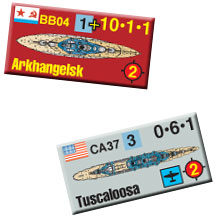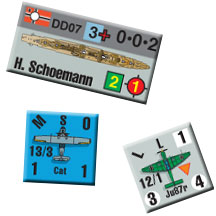| Arctic
Convoy:
A Designer/Publisher Perspective
By Mike Bennighof, Ph.D.
February 2014
Designing and producing games can be a deeply frustrating exercise. So can printing them. When it seems like it’s just an impossible task suited only to the pathologically stubborn, I remember that once upon a time it did all come together smoothly: with Second World War at Sea: Arctic Convoy.
The Second World War at Sea system was intended from the start as a universal model of World War II naval combat, and it does its job quite well in that regard – for some topics better than others, of course. Arctic Convoy hadn’t even been considered when the basic game was designed, yet the scenarios fit the system just about perfectly.
 Scenario design at its most basic consists of translating operational
details into game setups and victory conditions.
Sometimes those details are hard to come
by, but I had excellent source materials
in English and German, including convoy records. The goals of each side are very straightforward in ust about every scenario (get the convoys to Russia; stop the convoys from getting to Russia). Scenario design at its most basic consists of translating operational
details into game setups and victory conditions.
Sometimes those details are hard to come
by, but I had excellent source materials
in English and German, including convoy records. The goals of each side are very straightforward in ust about every scenario (get the convoys to Russia; stop the convoys from getting to Russia).
Production work
went smoothly, too. We have
a very fine cover, based on a period watercolor
by Dwight Shepler, and a lovely,
and very cold-looking, two-piece map. Many of the ship drawings are new for this game, and
that went forward without too much trouble (it's a lot of work, and it always is, but nothing weird happened during its course).

Arctic
Convoy was the last game we printed overseas, and getting it to the United States was extremely painful. Reprinting it in the U.S. has been a whole lot easier, and it's a game that we need to keep continually in print. Here's why:
Arctic
Convoy comes with two maps, covering
far northern seas from Iceland to Siberia.
While I know some fans hoped they would overlap
with those in Bismarck,
the Bismarck maps
were drawn using a different global projection.
Continuing them to the north resulted in
a badly distorted view, and so we went with
a fresh projection from the pole to keep
Iceland and Archangel at their proper relationship.
In practice, that's no problem at all. Both
Axis and Allies saw the Arctic and North
Atlantic as completely separate theaters
of war. Convoys for North Russia formed up
in Iceland, and their escorts worked out
of that future center of bank collapse or
from Scapa Flow, both of which are present
on both games' maps. Neither merchant nor
warships moved directly between them. The
Germans based their commerce raiders from
some of the same Norwegian ports, but didn't
move them directly from one area to the other,
either. Cruisers headed for the Atlantic
did so with a full load of fuel.
 There are just over 2 1/2 sheets of counters,
with all the expected ships and planes. The
pieces I wanted for the game design almost
exactly matched the number budgeted — I
did have to squeeze 20 counters out of Rumors
of War to give Arctic
Convoy some more transports.
But there was no desperate need to reduce
the counter count, or to fill blank cardboard,
as there usually is in game publishing. There are just over 2 1/2 sheets of counters,
with all the expected ships and planes. The
pieces I wanted for the game design almost
exactly matched the number budgeted — I
did have to squeeze 20 counters out of Rumors
of War to give Arctic
Convoy some more transports.
But there was no desperate need to reduce
the counter count, or to fill blank cardboard,
as there usually is in game publishing.
The Germans don't have many warships, but
then, they don't really need many. There's
a lot of water in which to hide, the weather's
going to protect them from Allied air searches,
and they pretty much know where the convoys
have to pass. The Allies have most of the
Royal Navy, plus a large contingent of American
ships and Canadian, Polish and Soviet vessels,
too. There's even a tiny Norwegian element
and a lone Australian ship.
For once, the Germans have air superiority.
Except for some long-range search planes
and a small Red Air Force element, the only
planes the Allies are going to deploy over
the convoys are those they bring with them.
Aircraft carriers are vital to cover the
merchant ships, yet in the abominable weather
they will have a hard time keeping their
planes aloft.
Scenarios cover the entire stretch of the
Murmansk Run, from the fall of 1941 until
early 1944. The famous convoy battles are
in there: Battle of the Barents Sea, North
Cape, PQ.17 and many more. There are also
lesser-known actions, like German-Soviet
destroyer clashes along the coast of Lapland
and the armored cruiser Scheer's raid along the Soviet
north coast.
In terms of play, it's similar to Bomb
Alley but with
much more open water and far dirtier weather.
The Allies are trying to push convoys along
a known route, in the face of enemy aircraft,
surface ships and submarines. The Axis
has only limited force, but can concentrate
it at a single point.
That makes for tense and exciting situation. The game play is great, the history is solid, and the production values are very good. Arctic Convoy is one damned fine game.
Click here to order Arctic
Convoy now! |


